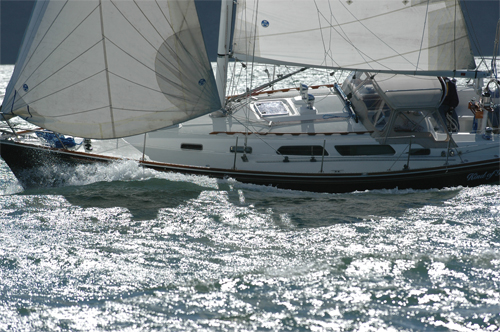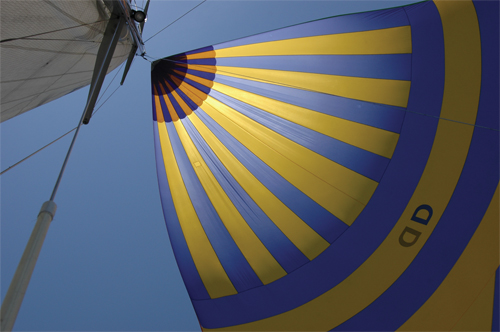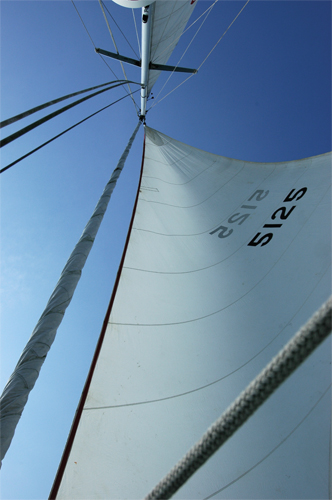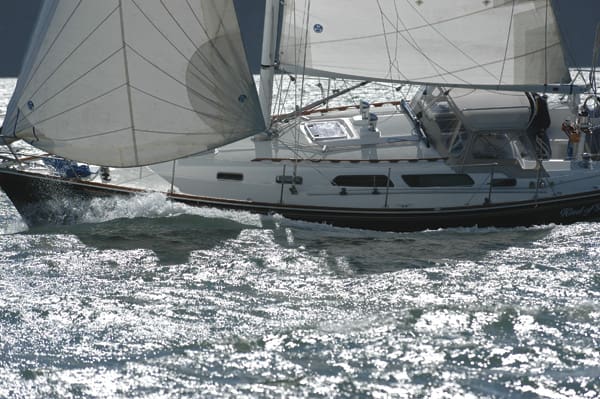 |
|
Dacron is a baseline choice for voyaging sails. |
The offshore sailor has a different set of sail inventory needs, in part due to increased stress and strain and in part due to a wider range of sailing conditions that define open ocean sailing. This day-in and day-out regimen is quite different from inshore cruising or around the buoys racing. The bottom line is that when it comes to offshore voyaging, the typical boat show two-sail inventory just doesn’t cover the bases.
What’s needed is a sail inventory capable of coping with a wider wind range and the dynamics of a churned up sea state. Ideally, it’s a specific set of better-built sails that are optimized for specific wind ranges, sea states and points of sail. The quest for the right sail inventory involves the design of the vessel, the attitude and agility of her crew and the challenges dictated by the seas.
When it comes to offshore voyaging sails, the details really count. For example, a higher cut clew has long been the insignia of an offshore voyager. Yes, the deck sweeping genoa or jib is more efficient on a lift per square foot basis, but when a good sized breaking sea slams into a no-stretch laminate, it can easily add up to a load never anticipated by a loft’s finite element analysis software. A higher cut clew allows a breaking sea to wash unabated across the deck. The amount of sail area sacrificed is rather small. In addition to better sea keeping, such a headsail foot configuration offers much better visibility for those on watch.
Minimizing wave contact
The mainsail of an offshore cruiser should also be fine-tuned to minimize water contact. In this case, it involves how reef points are designed and built into slab reefing mainsails. The contemporary trend in sail plans is toward larger mainsails and smaller jibs, and with such configurations come long footed mainsails and even longer booms. Powered up on a reach, with the vang tightened and a preventer set, the rhythmic roll of the boat can plunge the outboard end of the boom and clew of the mainsail into a wave face. Water does not compress and the result can be more than an annoying surprise. If the force vectors exceed the strength of the components the result may be damage to the mainsail or boom. One answer to this problem lies in the layout of the reef points themselves. By sewing in an intentional horizontal misalignment between the reef clew and tack points, the outboard end of the boom can be elevated when reefed. The game plan is to lessen the chance of the boom contacting the sea. Batten location and reef point load spreading need to be considered when making such changes in reef point geometry.
Those with a mainsail boom converted from a traditional slug or slide footed mainsail design to a free-footed mainsail need to be careful about the increased clew loads. For example, if a mid boom preventer is set up and the outboard end of the boom drags in the water, the attachment point of the preventer becomes a fulcrum and the water induced load at the outboard end of the boom acts in opposition. The resulting unanticipated leverage can easily kink the boom. An outboard boom end attachment of the preventer keeps the boom in compression and lessens the likelihood of such an occurrence.
Inshore sails usually have more draft, tend to maximize lift, and designers put less emphasis on reefing considerations and long-term durability. A good case in point is seen in mainsails built for boats with swept back spreaders. Off the wind, the mainsail plants itself against the relatively sharp trailing edge of the spreader, and in many cases there’s no doubled up anti-chafe patch to take the abuse. Even worse is what happens when the sail is reefed and the wind and sea are delivering punishment to a single layer of sail material rubbing on the trailing edge of a spreader. Extra reinforcement at spreader contact points on the mainsail are a must and that goes for when the sail is reefed as well as when it’s set in a full main configuration.
It makes sense to look at all the corners and make sure the design and the construction reflect durability. I’ve seen wonderfully shaped and sewn sails fail because an aluminum spacer was used in a pressed-in clew grommet, or a rugged alloy headboard was torn off because it abruptly connected to under-reinforced sail material. Sail corners are all about the art of spreading loads and understanding the implication of a stress riser. The term refers to a point in any structure where large changes in stiffness are found. The point where a headboard meets sailcloth is a classic case and the region where the clew reinforcement associated with a reef point transitions to a single layer of sailcloth is another. By gradually tapering many layers to one, adding webbing that radiates from the attachment points or using high modulus materials in higher loaded regions, a sailmaker can engineer in more strength.
 |
 |
|
Above, A good example of radial construction is the head of this spinnaker, which is built with radiating panels that carry the load to the single point of the head fitting. Below, A light air sail like this reacher set on its own removable roller furling gear can fill the foretriangle in easy conditions and be struck when the wind increases. |
Matching a wider wind range
Before selecting a sail inventory, the offshore bound skipper needs to think about the attributes of his or her vessel and crew. Adding an asymmetric spinnaker to a short rigged heavy displacement ketch may make for a great holiday card photo, but the sail will probably not deliver enough drive in lighter air conditions, and be too much for a short-handed crew to cope with in a heavier breeze. There’s also the question of who will steer, and for most short-handed crews it’s often the auto pilot or self steering vane. Some sailors are willing to cope with an asymmetric spinnaker while others will not. So before adding a sprit, track for a pole, winches and other light air sail accouterments, be sure the disposition of the crew is in sync with the string pulling, and the vessel is agile enough to benefit from light air sails deployed in conditions of 10 knots or less. Trying to use them in higher wind velocities with a short-handed crew ups both the anxiety factor and the skill set needed.
Not every sailor wants to cope with light air under sail, nor are all boats able to make sufficient progress in such conditions. So for many long-distance cruisers it makes just as much sense to optimize the iron genoa by adding an extra fuel tank, installing an efficient prop and accepting that light air motor sailing is a perfectly valid means of getting from here to there.
Sail plan preferences
Sloops own the waterfront, and it’s due to their cost effectiveness and performance capability on all points of sail. One mast, one boom and one set of chain plates add up to less weight and cost and more efficiency per square foot of sail area. Ketches and schooners can make the art of sail wrestling more manageable, and that can be an important factor for a short-handed crew handling a larger vessel. Spreading sail area fore and aft rather than higher may be less efficient and makes little sense to a hardcore racer out to maximize lift per square foot of sail area. But for the short-handed cruiser, handling smaller sails can make lots of sense, especially when trapped in the grasp of a squall.
Many modern cruising sloops sport multiple roller furling headsails that behave like a pro photographer’s preference for two cameras with mid range zooms rather than one body and lens covering the entire range. One of the fastest growing offshore options found aboard masthead rigged sloops is a permanently attached Solent jib. This smaller sail resides on a roller furler that’s tacked only a couple of feet back from the stem, and runs on a foil attached just below the masthead sheave box. Slotted into this foil over wire furler is a high cut working jib that can be roller reefed to about 70 percent of the fore triangle area — just right for beating into heavy air. The jib is made of heavy Dacron or lighter weight, higher modulus composite sail material, and is tough enough to be used partially furled while reaching or running in gale force conditions. It’s not a replacement for a storm jib, but it does cover the 18- to 35-knot spectrum, and like a good zoom lens works well at both ends of its range.
At the stem, just ahead of this Solent jib, is another roller furler with a larger genoa or reacher that’s used upwind in very light air conditions or off the wind in a much wider wind range. The sail is usually designed for on-the-wind sailing in 10 knots or less, and it also excels in 12- to 20-knot reaching conditions. The drawback of this one/two approach is that the larger headsail is all but impossible to conventionally tack due to the small slot between the Solent stay and the headstay. Consequently, the sail is usually furled and unfurled during the tacking process. This is quite acceptable on long legs offshore, but it can be a nuisance when beating up a tight channel. This is why many sailors opt for a removable Solent stay and hank on a small headsail when the going gets tough. The use of a hank on, high cut working jib works well with this removable stay.
The second Solent and reacher issue concerns the fact that this sail plan provides only an either/or option. It’s the proximity of the tack points of the two sails that eliminates the possibility of using the two sails as an effective double headsail (cutter) rig. A big advantage, however, lies in the geometry of the attachment of the Solent stay to the mast. The upper end is secured just below the headstay at a point that eliminates the need for runners, check stays or an aft led intermediate stay.
Cutter rig provides options
Far from being reconciled as cruising nostalgia, the cutter rig is alive and well. In a nutshell, a true cutter sail plan has close to a 50/50 split of sail area between the working headsails and the mainsail. The headsail area is broken up into a smaller staysail and larger headsail, but contrary to the Solent stay arrangement, the forestay is tacked well aft of the headstay and the mast tang is usually around the upper set of spreaders on a double spreader rig. The slot is larger and even midsized genoas can be coaxed between the two stays during a conventional tack. The key drawback is that additional support for the mast is needed so that the load on the inner stay does not pull the mast out of column. This can be achieved with running backstays that must be switched with each tack. Aboard more conservatively rigged vessels with stiffer spars, runners may only be needed when the wind is up or the vessel is pounding into a seaway. Another viable option used by some designers is the addition of port and starboard acute angled intermediate stays. These aft-swept 1×19 wires offset the pull of the forestay, but they also become an obstacle to an eased mainsail, and care must be taken to prevent chafe damage to sail cloth and stitching.
The cutter rig has more upside than downside and its headsail versatility and handling ease tops the list. For those who prefer to make passages under sail there’s an easy-to-handle sail option for every wind condition. My own boat’s inventory includes a 160 percent two-ounce drifter/reacher on a Selden continuous loop furler. The tightly-rolled sail is hoisted on a spinnaker halyard and tacked to a short, removable deck level sprit. Once in place, with the ultra light New England Ropes Flight Line non-water absorbing sheets attached, all it takes is a tug on the sheet to deploy a great answer to light air reaching. This is an all-or-nothing roller furled sail, there’s no luff foil, the sail rolls on its own reinforced luff and it can be easily lowered and stowed in a bag with the endless line furler drum, head swivel and sheets all attached. It’s a snap to set, unfurl and best of all, when the breeze fills in and it’s time to switch to the headsail, simply easing the sheet and pulling on the furling line tames the oversized reacher.
Roller-furled headsails
The workhorse of any cutter’s sail plan is the same as what’s found on any sloop. The roller furling headsail dominates the market and its convenience, reliability and versatility has been proven. The midsized 120 to 135 percent genoa covers the average 10- to 20-knot wind range nicely, but depending on the sail area displacement ratio of your boat, one end of this wind range will give you problems sooner than the other. The trouble with a roller furling/reefing headsail is what I call the “backed into a corner” effect. As the wind increases, less and less sail area needs to be exposed, and thanks to the jib furlers window shade-like roll up capability, the sail area can easily be reduced. Unfortunately, sooner or later the draft moves aft and the foot and/or leech flutter gets worse. The genoa track may not be long enough to set the correct sheet lead angle, and it’s clear that it’s time to change to a much smaller, heavier headsail. An optimist might say that this only takes three simple steps — completely unfurl the genoa, strip the flogging sail from luff and hoist the new smaller sail. But the process can be a challenge in darkness with cold breaking seas sweeping the foredeck.
The alternative is a Solent stay or conventional cutter rig. Both offer a smaller sail rolled up and ready to hoist on a separate stay. Whether it’s a gradually building breeze or the impact of a gnarly squall line, the result can be handled with an easy down shift in sail area. Start by furling the troublesome genoa and switch to the smaller sail. The process moves the center of effort aft just as reefing the mainsail moves it forward. The result is that the boat remains well balanced even though the sail area has been dramatically reduced.
——————-
Ralph Naranjo is a sailor, freelance writer, photographer and former head of Navy sailing at the U.S. Naval Academy. His five-year circumnavigation on his 41-foot sloop Wind Shadow, is told in his book Wind Shadow West.

